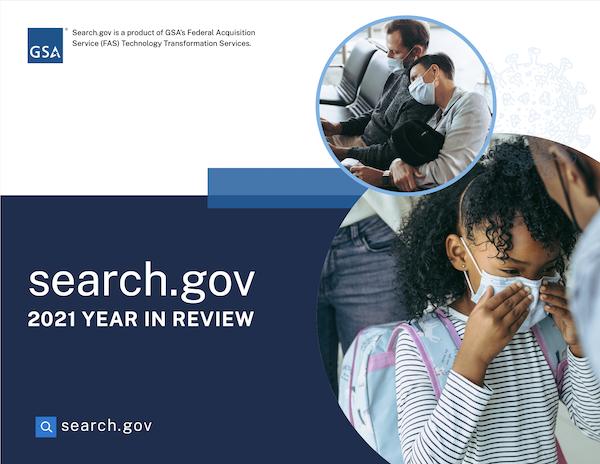2021 Year In Review
286.5 million searches
2,100+ participating gov websites
18 top topics
365 days of connecting people with what they need
Search.gov is a search engine service provided by the GSA’s Technology Transformation Services. Used by one-third of federal domains, it provides a high-quality, standard search experience for the public as they interact with different government websites. The service’s broad use gives insight into not only what services and information the public needs, but how people seek it out. Often, web analytics just show what resources people used. Search data shows why people went to get those resources.
This Year In Review explores the top needs of 2021, expressed in the public’s own words. For each of the 18 topics, this report provides the top 25 searches in that topic, trend data since 2019, and the top websites serving the public in that area.
The top five topics in 2021 were:
- Benefits
- Loans
- Immigration
- Space
- Health
The Long Haul
The story of 2021 is one of perseverance. COVID continued to weigh heavily on our daily lives. We attempted to return to normal, but normal was out of reach. The lack of normalcy can be seen in the prolonged increased need for financial assistance. Last year was the first time Loans was tracked in this report series and with 20 million searches, continued to place second this year. Searches for Loan forgiveness decreased 30%, but remained 3.5 times higher than pre-COVID levels.
Searches for health topics remain nearly double the level of a typical year, though about 10% lower than 2020. The main focus of COVID-19-related health searches shifted from symptoms and protection to vaccines and testing.
Immigration related searches had remained steady between 2019 and 2020, and increased 10% in 2021. Forms, usually one of the top needs, dropped out of the top 5, with total requests 17% lower than 2020. For the first time this year, we investigated the topic of Infrastructure, given that this is a priority for the administration. Though it’s a broad enough subject that it didn’t rise to the top through any particular search terms, Infrastructure as a whole turned out to be among the top topics, with searches such as “energy,” “roads,” and “communications lines.”
Public Experience - How Do People Search?
Search.gov’s broad use in government gives us a bird’s eye view of public behavior in search, no matter what website a person may have gone to. We see categories of need that link different topics together, as well as how individual people are searching: How many words do they use? How do they format their searches? Where do they start their search - from an internal page or directly from the home page?
Similar to every year, in 2021 we saw the public express very complex needs in very vague terms. Sixty percent of all COVID-19 searches were done using just one, two, or three words. The most common pandemic-related search in 2021 was simply “covid” (25%), followed by “coronavirus” (11%), and, getting somewhat more specific, “covid vaccine” (7%) and “vaccine” (6%). Half of all pandemic-related searches were these four simple queries.
One surprising finding this year is that searches in the form of a question, such as “how do I apply” or “what is my case status,” have decreased over time. The rising popularity of digital voice assistants has led many to suggest that search is becoming more conversational. However, in 2019 there were over 8 million searches including question words, in 2020 there were 7.8 million, and in 2021 there were only about 5.8 million searches in the form of questions.
According to data from the Digital Analytics Program, about 40% of visits to federal government websites begin with a search in a commercial search engine, and 20% start with a person going straight to the website. For people who then search on the site, we see in our data that one third start searching from the home page. Two thirds search from internal pages, indicating that they first browsed around before using the search. They also may have been on those internal pages after arriving from a commercial search engine.
Since we don’t track individual searchers, we cannot show a complete journey from beginning to end. However, the themes and trends in site search data provide government with a considerable amount of information to improve the public experience with navigating government information.
Methods
The Search.gov system collects unsampled data about search traffic through our service. It allows us to see what searches were run on any participating websites. We’re also able to see what webpages people were on when they ran their searches, and what they clicked on from the search results page. We do not track individual people.
For this report, we use an analysis method designed to detect the topic of the search from any of these data points: the search term, the URL of the selected search result, the website being searched, or the webpage being searched from. For example, a person searching for an application form may use the word “forms” or they may search using a specific form name, but select a search result from the website’s forms folder. We also consider how different searchers may use different words to talk about the same idea, such as “lost green card” or “i-90,” the USCIS form number to apply for a replacement green card.
The time frame studied was January 1 - December 31, 2021.
Read our 2021 system highlights, an overview of the biggest improvements we made to our system last year.

